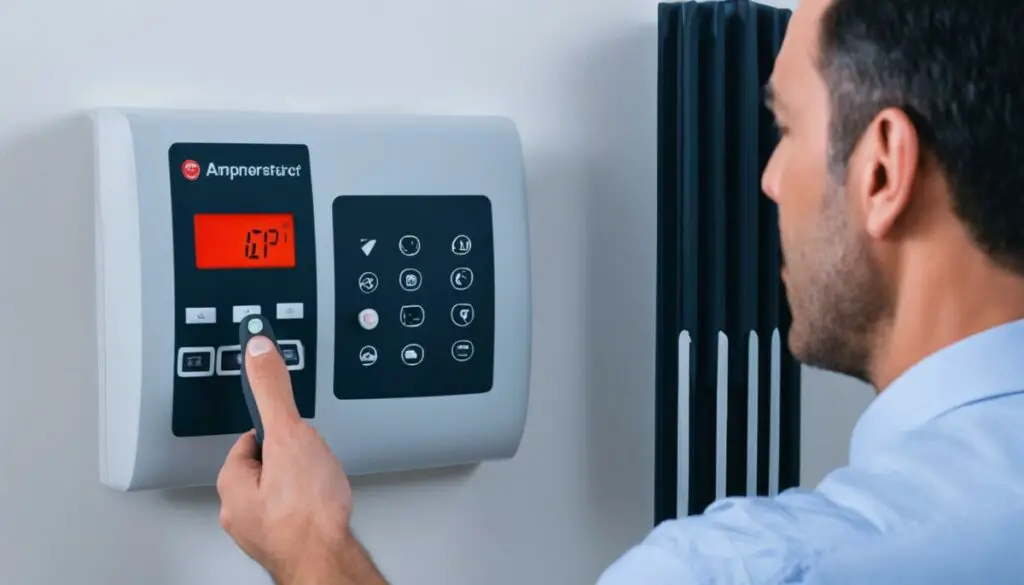Last Updated on 4 months by Francis
Infrared waves play a significant role in modern communication technology. They are invisible to the human eye but have a wide range of applications, including wireless communication and data transmission. In this article, we will explore how infrared waves are used in communication and their various uses in everyday life.
Contents
Key Takeaways:
- Infrared waves are used in wireless communication and data transmission.
- Infrared waves are invisible to the human eye but can be detected by heat sensors.
- Infrared communication offers advantages such as cost-effectiveness and interference-free transmission.
- However, it has limitations related to range, line of sight, and transmission speed.
- Infrared communication is widely used in everyday life, from remote controls to security systems.
The Different Bands of Infrared Waves

Infrared waves are classified into three bands based on their wavelengths: near-infrared, mid-infrared, and far-infrared. Each band has its own unique properties and applications in communication.
Near-Infrared
Near-infrared waves have the longest wavelengths and lowest frequencies among the three bands. They range from 700 nanometers to 1,300 nanometers. Near-infrared waves are commonly utilized in various communication applications, such as remote controls and fiber optic cables.
Mid-Infrared
Mid-infrared waves fall within the range of 1,300 nanometers to 3,000 nanometers. They find extensive use in communication technologies, including heat sensors and thermal imaging devices. These waves can detect and measure thermal variations, making them ideal for temperature-sensitive applications.
Far-Infrared
Far-infrared waves have the shortest wavelengths and highest frequencies among the three bands. They range from 3,000 nanometers to 1 millimeter. Far-infrared waves are primarily associated with heat and are commonly used in applications such as night vision equipment. They enable the detection of heat signatures and thermal patterns.
These different bands of infrared waves play a crucial role in various communication technologies, allowing for efficient data transmission and the development of innovative devices.
Uses of Infrared Radiation

Infrared radiation, with its diverse range of applications, plays a crucial role in various fields. In the realm of communication, infrared technology is utilized extensively for both wired and wireless operations.
One of the most common uses of infrared waves in communication is found in remote controls. These devices employ near-infrared light, transmitted through Light Emitting Diodes (LEDs), to send signals to televisions and other electronic equipment. By simply pointing the remote control at the desired device, users can effortlessly navigate through channels, adjust volume, or power on/off.
Infrared technology also finds its utility in networking and data transmission. Fiber optic cables, which employ infrared light, enable high-speed data transfer over long distances. This makes them particularly useful in industries that require efficient communication, such as telecommunications and computer networking. Additionally, infrared is extensively utilized in wireless communication technologies, facilitating fast and reliable data transfer between devices.
Aside from communication, the applications of infrared radiation are vast and diverse. Its use in heat sensing enables the accurate detection of temperature variations, making it invaluable in industries like manufacturing, aerospace, and environmental monitoring. Thermal imaging, another application of infrared technology, allows for the visualization of temperature differences and is employed in fields such as healthcare, construction, and law enforcement.
Night vision equipment, often employed by the military and law enforcement agencies, utilizes infrared technology to detect and capture images in low-light or complete darkness. Infrared radiation, being naturally emitted by warm bodies, enables enhanced visibility in dark environments, aiding surveillance, tracking, and rescue missions.
Furthermore, astronomers utilize infrared radiation to observe and study celestial objects. Infrared telescopes allow astronomers to detect faint objects obscured by dust and gas in space. This technology provides valuable insights into the formation of stars, galaxies, and the universe itself.
Overall, the uses of infrared radiation extend far beyond communication. From heat sensing to night vision and astronomical observations, infrared technology continues to revolutionize various industries, enhancing productivity, efficiency, and our understanding of the world around us.
“Infrared technology enables efficient communication and empowers industries across the board.”
Benefits of Infrared Technology in Communication:
- Reliable wireless communication: Infrared waves enable wireless communication without the need for physical connections, allowing for easier and more flexible communication systems.
- Interference-free transmission: Infrared signals are not easily affected by radio frequency interference, ensuring reliable and uninterrupted communication.
- Secure transmission: Infrared waves do not easily pass through walls or other obstacles, making it a secure communication medium.
- Cost-effective: Infrared technology is widely available and cost-effective, making it a practical choice for various applications.
How Infrared Communication Works

Infrared communication is a simple and cost-effective method of wireless communication. It utilizes infrared light, which is not visible to the human eye, to transmit data between devices. The process involves the use of infrared light-emitting diodes (LEDs) that emit light at around 950 nanometers in wavelength.
When transmitting data, the sender modulates the infrared LED by pulsing it on and off at a specific frequency, typically around 38,000 Hz. This pulsing creates a unique signal that can be differentiated from other sources of infrared radiation. The receiver, equipped with an infrared receiver module, detects and decodes the pulsing signal to retrieve the transmitted data.
Infrared communication protocols, such as the NEC protocol and the RC5 protocol, play a crucial role in defining the pattern and encoding of the data bits. These protocols ensure that the transmitted data is properly formatted and can be accurately interpreted by the receiving device.
Infrared communication offers several advantages in various applications. Firstly, it allows for low transmission speeds, making it suitable for devices with slower microcontrollers. Additionally, infrared communication is widely used in consumer electronics, such as remote controls, due to its simplicity and cost-effectiveness.
However, it is important to note that infrared communication has limitations. The effective range is relatively short compared to other wireless communication technologies, and it requires a clear line of sight between the transmitter and the receiver. Ambient light, sunlight, and other sources of infrared radiation can also interfere with the signal. Despite these limitations, infrared communication continues to be widely used in everyday devices and plays a significant role in wireless communication systems.
The NEC Infrared Transmission Protocol

The NEC protocol is a widely used infrared communication protocol that has been adopted by numerous devices and systems. It utilizes pulse distance encoding to distinguish between logic states. The carrier frequency commonly associated with the NEC protocol is 38 kHz, providing a stable and reliable communication medium.
Binary values are encoded in the NEC protocol using bursts of specific durations, representing logical 1 or logical 0. Each message frame in the protocol consists of several components, meticulously arranged to ensure accurate transmission and interpretation of data. These components include:
- A leading pulse burst: This signal at the beginning of the message serves as a synchronization mechanism, allowing the receiver to identify the start of the transmission.
- A low period: This is a pause or gap between the leading pulse burst and the subsequent data components, ensuring clarity and separation.
- The device’s address: This section of the message frame contains the unique identifier for the transmitting device, enabling the receiver to differentiate between different senders in a multi-user environment.
- The logical inverse of the address: This component provides redundancy and error-checking capabilities by including the logical inverse of the device’s address.
- The command: The command section carries the specific instruction or action that the transmitting device intends to convey to the receiver.
- The inverse of the command: Similar to the address, the command’s inverse is included to enhance the protocol’s resilience to errors.
- A final burst: This concluding burst is a clear indication that the message transmission is complete, allowing the receiver to terminate the decoding process.
The NEC protocol also supports additional features such as repeat commands and checksum verification to ensure accurate and reliable communication between devices.
Implementing the NEC protocol in infrared communication provides a standardized and efficient method for transmitting data. Its widespread adoption and inherent reliability make it a popular choice for various applications, including remote controls, smart home automation systems, and other consumer electronics.
Below is an example of the NEC protocol message frame:
| Component | Description |
|---|---|
| Leading Pulse Burst | Starts the message and provides synchronization |
| Low Period | A pause between the leading pulse burst and the data components |
| Device’s Address | Unique identifier for the transmitting device |
| Logical Inverse of the Address | Inverse of the device’s address for error-checking |
| Command | Instruction or action to be conveyed to the receiver |
| Inverse of the Command | Inverse of the command for error-checking |
| Final Burst | Signals the end of the message transmission |
By adhering to the NEC protocol, devices and systems can communicate seamlessly and reliably using infrared technology.
The RC5 Infrared Transmission Protocol

The RC5 protocol, developed by Philips, is one of the popular infrared communication protocols used in various devices. It utilizes Manchester encoding, where logical bits are differentiated based on the order of pulses and low periods. The RC5 protocol operates at a carrier frequency of 36 kHz, ensuring reliable transmission across different devices.
The RC5 message frame consists of start bits, a toggle bit, address bits, and command bits. Each message, including all the necessary information, takes approximately 24.892 ms to transmit. The toggle bit is an essential element in the RC5 protocol as it allows the detection of repeated signals or continuously pressed buttons.
The simplicity and fixed transmission time of the RC5 protocol make it highly suitable for infrared communication. It enables efficient and reliable data transfer, ensuring compatibility between different devices implementing this protocol. The RC5 protocol is widely used in consumer electronics, including televisions, DVD players, and set-top boxes, where a standard and easy-to-implement communication protocol is required.
Here is an example of how the RC5 protocol message frame is structured:
| Start | Toggle | Address | Command |
|---|---|---|---|
| 14 bits | 1 bit | 5 bits | 6 bits |
The RC5 protocol offers a reliable and straightforward solution for infrared communication, making it a widely adopted standard in the industry.
Infrared Communication in Everyday Life

Infrared communication is a widely used technology in various aspects of everyday life. It plays a significant role in communication technologies using infrared waves. Let’s explore some of the common applications of infrared communication:
1. Remote Controls: One of the most recognizable uses of infrared communication is in remote controls. By utilizing infrared signals, remote controls allow us to wirelessly operate devices such as televisions, audio systems, and other home entertainment devices.
2. Household Appliances: Many household appliances also employ infrared communication. Air conditioners, for example, can be controlled using infrared signals. Additionally, garage door openers often rely on infrared technology to facilitate efficient and convenient usage.
3. Industrial Systems: Infrared communication finds valuable applications in industrial settings. It enables data transmission and control systems, enhancing the efficiency and effectiveness of various processes in manufacturing and production environments.
4. Security Systems: Infrared sensors are extensively utilized in security systems for motion detection and access control. These sensors detect infrared radiation emitted by objects or individuals, enabling reliable detection and monitoring in both residential and commercial spaces.
In summary, the prevalence of infrared communication in everyday life is evident in the widespread use of remote controls, household appliances, industrial systems, and security systems. These applications harness the power of communication technologies using infrared waves to enhance convenience, efficiency, and security.
Infrared Communication Applications
| Application | Description |
|---|---|
| Remote Controls | Allows wireless operation of devices like televisions and audio systems |
| Household Appliances | Utilized in air conditioners and garage door openers for convenient control |
| Industrial Systems | Enables efficient data transmission and control in manufacturing environments |
| Security Systems | Used for motion detection and access control in residential and commercial spaces |
Advantages of Infrared Communication

Infrared communication offers several advantages that make it a desirable technology for various applications. Let’s explore some of the key benefits:
- Wireless Convenience: Infrared communication is a wireless technology, eliminating the need for physical connections. This makes it convenient for a wide range of applications and allows for greater flexibility in device placement.
- Cost-Effectiveness: Implementing infrared communication is cost-effective compared to other wireless communication technologies. It requires less complex infrastructure and equipment, reducing the overall cost of deployment.
- Widespread Availability: Infrared technology is widely available and compatible with many devices. This accessibility ensures compatibility across different brands and product lines, increasing its practicality in a variety of scenarios.
- Immune to Radio Frequency Interference: Infrared waves are not affected by radio frequency interference, which can disrupt other wireless communication technologies. This makes infrared communication more reliable and less susceptible to signal degradation or loss.
- Secure Transmission: Infrared signals do not easily pass through walls or obstacles, providing a certain level of inherent security. This characteristic makes infrared communication suitable for applications where data privacy is important.
- Short-Range Communication: Infrared communication is typically utilized for short-range communication, which is advantageous in scenarios where localized and direct communication is required. This makes it an ideal choice for applications like remote controls.
- No License Requirement: Unlike some other communication technologies, infrared communication does not require a license for use. This reduces operational complexities and associated costs, making it more accessible for both individuals and businesses.
By harnessing the benefits of infrared communication, various industries and everyday users can enjoy wireless convenience, cost-effectiveness, and secure data transmission.
| Advantages | Description |
|---|---|
| Wireless Convenience | Eliminates the need for physical connections, providing flexibility in device placement. |
| Cost-Effectiveness | Requires less complex infrastructure and equipment, reducing overall deployment costs. |
| Widespread Availability | Compatible with many devices, ensuring practicality across different brands and product lines. |
| Immune to Radio Frequency Interference | Infrared waves are not affected by radio frequency interference, ensuring reliable communication performance. |
| Secure Transmission | Infrared signals do not easily pass through walls or obstacles, providing inherent security for data transmission. |
| Short-Range Communication | Ideal for localized and direct communication requirements, making it suitable for applications like remote controls. |
| No License Requirement | Does not require a license for use, reducing operational complexities and associated costs. |
Limitations and Challenges of Infrared Communication
Despite its advantages, infrared communication also faces certain limitations that need to be considered. Understanding these limitations is crucial for the effective implementation and utilization of infrared communication technology.
- Effective Range: One of the significant limitations of infrared communication is its relatively limited range compared to other wireless communication technologies. Infrared signals have a shorter reach, making them suitable for short-range applications rather than long-distance communication.
- Line of Sight: Infrared communication requires a clear line of sight between the transmitter and the receiver. Any obstructions, such as walls or objects, can disrupt the transmission, making it necessary to ensure a direct and unobstructed path between the devices.
- Ambient Light and Interference: Infrared signals are sensitive to ambient light, sunlight, and other sources of infrared radiation. These external factors can interfere with the clarity and reliability of the communication, potentially affecting the transmission quality.
- Transmission Speed: When compared to other wireless technologies, the transmission speed of infrared communication is relatively slow. While it may not be a concern for applications that do not require high data transfer rates, it may limit the usability of infrared communication in scenarios where faster data transmission is necessary.
These limitations make infrared communication better suited for short-range communication and indoor environments, where obstacles and interference can be minimized.
Conclusion
Infrared waves are a vital component of modern communication technology, finding applications in various industries and everyday life. From the convenience of remote controls to the efficiency of wireless networking, infrared communication offers numerous advantages. It is a cost-effective solution that enables secure and interference-free data transmission. However, there are limitations to consider, such as the limited range, line-of-sight requirement, and relatively slow transmission speed. Despite these limitations, infrared communication remains a widely used technology.
As technology continues to advance, we can expect further developments and improvements in infrared communication systems. These advancements may address the current limitations and open up new possibilities for this versatile technology. Infrared waves will continue to play a crucial role in facilitating effective and efficient communication across various domains.
FAQ
Are infrared waves used in communication?
Yes, infrared waves are used in communication. They are commonly used in applications such as remote controls, fiber optic cables, and wireless communication systems.
What are the different bands of infrared waves?
Infrared waves are divided into near-infrared, mid-infrared, and far-infrared bands based on their wavelengths and frequencies.
What are some uses of infrared radiation in communication?
Infrared radiation has various applications in communication, including heat sensors, thermal imaging, night vision equipment, and remote controls.
How does infrared communication work?
Infrared communication uses infrared light to transmit data wirelessly. Infrared LEDs emit light that is not visible to the human eye, and the data is encoded and transmitted through pulses of light.
What is the NEC infrared transmission protocol?
The NEC protocol is a widely used infrared communication protocol that defines the pattern and encoding of data bits transmitted through infrared signals.
What is the RC5 infrared transmission protocol?
The RC5 protocol is another popular infrared communication protocol developed by Philips. It uses Manchester encoding to differentiate logical bits in the transmitted data.
Where is infrared communication commonly used in everyday life?
Infrared communication is commonly used in devices such as remote controls, home entertainment systems, household appliances, and industrial control systems.
What are the advantages of infrared communication?
Infrared communication offers advantages such as cost-effectiveness, secure transmission, and immunity to radio frequency interference. It is also widely available and does not require a license for use.
What are the limitations and challenges of infrared communication?
Infrared communication has limitations related to its range, line of sight requirement, and relatively slow transmission speed compared to other wireless technologies.
What is the role of infrared waves in communication technology?
Infrared waves play a significant role in communication technology, being utilized in various applications and technologies for wireless and wired communication.








